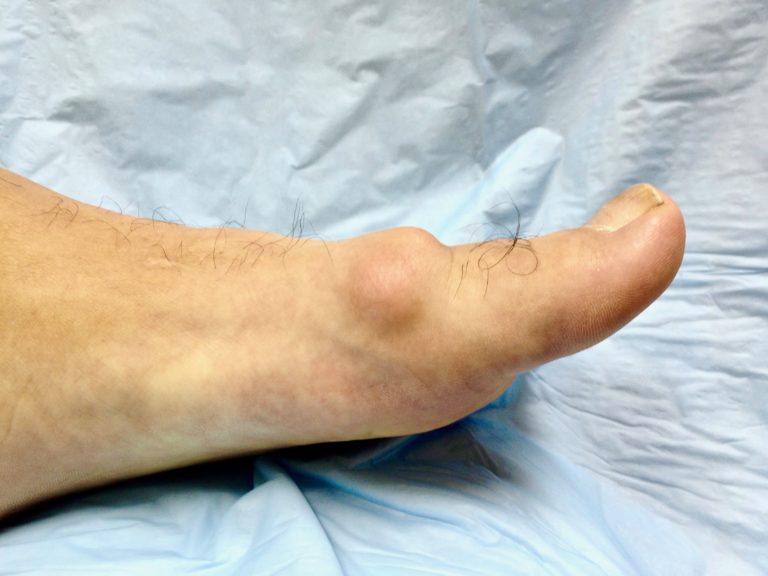Hallux Limitus / Osteoarthritis
Watch the video above to learn about Hallux Limitus / Osteoarthritis, and how I approach treating this with my patients. There's also more information below. As always, when you're ready, fill out the form on this page to request a consultation.
After surgery, I can do my normal thing. It has made my life come back to normal. You could not get a better doctor, podiatrist wise, than Dr. Stewart. — Jerry

Osteoarthritis, also known as degenerative arthritis, refers to mechanical breakdown of the joint surfaces in one or more joints. In its early stages, there is joint inflammation, yet over time this is a mechanical arthritis. Osteoarthritis is the most common form of arthritis.
Although more common in older individuals, younger individuals are certainly susceptible to developing osteoarthritis as a result of high levels of physical activity. Osteoarthritis is common in athletes and physically active individuals as the joints are subject to mechanical breakdown over time. This condition is generally thought of as a “wear and tear” disease as the joint surfaces continuously wear down over time.
Hallux Limitus/Rigidus
All joints in the foot and ankle are subject to osteoarthritis, yet osteoarthritis is most commonly found in the 1st metatarsal phalangeal joint (big toe joint or 1st MPJ). Osteoarthritis of this joint is referred to as hallux limitus/rigidus. In hallux limitus/rigidus, there is limited motion of the hallux at the 1st metatarsal phalangeal joint
Symptoms
- Joint pain and swelling
- Limited motion or joint stiffness
- Prominent bone or spurring on top of the 1st MPJ
- Joint crepitus also known as grinding of the joint with motion
- Pain in adjacent joints as they compensate for decreased motion in the affected joint. With hallux limitus/rigidus, pain is typically transferred to the 2nd metatarsal phalangeal joint or to the hallux interphalangeal joint
- Difficulty walking
- Callus to the bottom of the 2nd MPJ or hallux IPJ
- Pain with shoe gear as a result of irritation along the bone spur
Diagnosis
Diagnosis is made by a comprehensive foot exam by Dr. Stewart along with x-rays of the foot.
Treatment
Dr. Stewart recommends exhausting all conservative treatment prior to surgical intervention. Unfortunately, osteoarthritis (including hallux limitus/rigidus) is a progressive arthritic condition and therefore pain can be challenging to manage.
I was diagnosed with hallux limitus/arthritis in my right big toe. I particularly had pain going down stairs and with driving. After meeting with you and trying conservative measures like orthotics and cortisone shots, I opted for surgery. Surgery was successful. I was back in a sneaker at 6 weeks and 100% pain free! – Sharon Peterson
Conservative treatment for Osteoarthritis includes:
- Anti-inflammatory medications (NSAIDS) in the early stages
- Tylenol
- Shoe gear modification to prevent irritation against boney prominences
- Steroid injections
- Custom foot orthotics and bracing
- Avoidance of flip-flops, flats, and barefoot walking
- Ice and elevation
- Supportive shoe gear including a motion control running shoe such as Brooks, Aasics, New Balance, or Saucony; Keen and Merrell style shoes are also recommended
- Modification of physical activity including avoidance of walking, jogging, running, and the elliptical for exercise; recommended exercises include circuit training, swimming, and bicycling
- Physical therapy
If conservative treatment is insufficient to treat the symptoms, then surgical intervention is required. Dr. Stewart will determine which procedure is best for you. The surgical procedure is determined by the condition of the joint at the time of surgery. For patients that undergo a joint sparing procedure, they are reminded that osteoarthritis is a progressive condition and they may require additional surgery in the future.
Surgical treatment for Osteoarthritis includes:
- Removal bone spurs
- Joint implant
- Joint fusion (arthrodesis)
- Joint decompression
- Subchondral bone drilling
Surgical treatment for Hallux Limitus includes:
- Cheilectomy procedure
- Arthroplasty procedure
- Cutting of bone (osteotomy) with use of screws to decompress the joint space
- Joint implant
- Joint fusion (arthrodesis)
- Subchondral bone drilling
